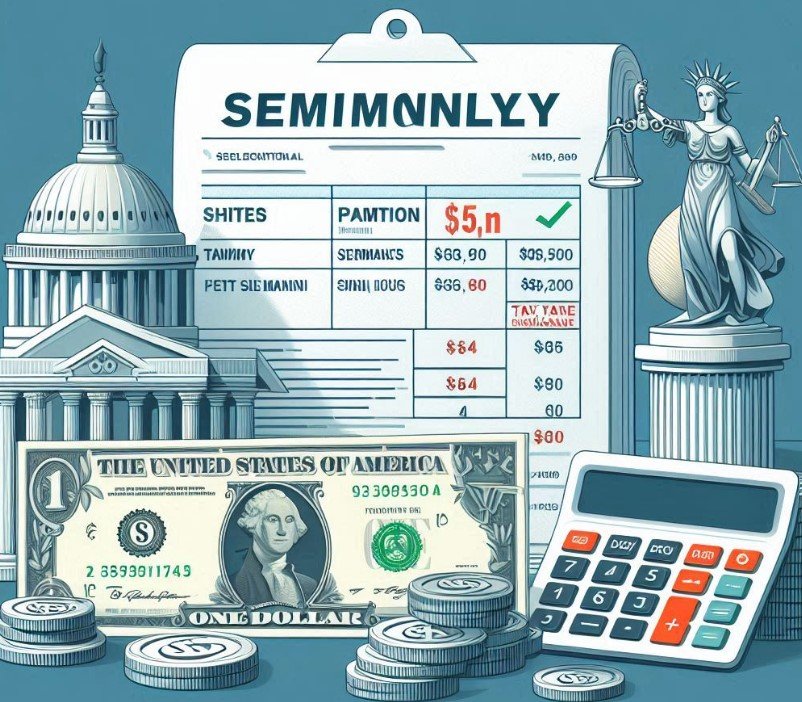In this post, I’ll explain How Does Semi Monthly Pay Work? This pay schedule offers the employee two consistent paychecks a month. It can also help a person budget and plan what they spend. Find how semi-monthly pay can offer benefits to both your company and employees.
How Does Semi Monthly Pay Work?
Semi-monthly pay is twice-a-month pay for employees’ wages. During this kind of pay system, the worker gets the wages on a specified date two times in a calendar month. 24 paychecks take place within a given year.
The greatest benefit is that the employee gets better control of his own finances since he or she will know exactly when it will be paid. There could also be ease in processing payroll for the employer because there is an allocated number of paydays monthly.

What Is Semi Monthly Pay?
Semi Monthly Pay usually occurs on specific dates mostly, the 15th and the end dates of the month. Under this system, employees get 24 paychecks per year. Each paycheck represents the amount earned for half a month of work. This schedule helps employees manage their finances with predictable paydays.
Under a semi-monthly pay, the payroll would usually fall into line easily with monthly expenditure by the employer. However, the pay period may have some slight difference in the hours worked as a result of the variations between the months. For example, February might have fewer working days than any other month. This must be quite keenly calculated when finding wages.
What Are The Advantages Of A Semi-Monthly Pay Schedule?
There are some advantages of A Semi-Monthly Pay Schedule
Predictable Paydays
A semi-monthly pay schedule promotes pay stability among employees, as paydays regularly fall on the 15th of every month and the end month period. This stability in paydays is important for the employees as it aids them in devising a strategy for managing their monthly finances as well as controlling their monthly spending.
Simplified Payroll Processing
For employers, semi-monthly pay will simplify payroll administration. It makes payroll management less complex compared to weekly or bi-weekly pay schedules. Thus, it is easier to coincide with monthly financial planning.
Coincidence with Monthly Expenses
It can be aligned with most recurring monthly bills, including rent and utilities. As such, it is easier for the employee to handle cash flow since they can have the funds available at the right time when these essential expenses fall due.
What Are The Cons Of Getting Paid Semi-Monthly?
The benefits of semi-monthly pay are quite numerous, whereas the opposite cannot be said concerning disadvantages.
- One disadvantage would be that employees might be confused while trying to understand how many hours they have worked since the pay periods are only half a month. As a result, hours change greatly from check to check. This brings confusion and can have bad effects on personal budgeting.
- Another con is the complication of the calculations, especially over time. The employees may have to be more vigilant about tracking their time. Some employees may also prefer bi-weekly pay for its alignment with their spending habits. If the pay schedule does not align with their preferences, it may lead to dissatisfaction. Overall, it’s always important for businesses to consider employee preferences when setting up a pay schedule.

How Do You Calculate Semi-Monthly Pay?
To compute semi-monthly pay, take the total annual income of the worker and divide that by 24. For instance, imagine an employee with a 60000 dollar salary. He will be remitted 2500 US dollars every two weeks. This amount will be the gross pay, not net pay.
In the case of an hourly employee, his or her semi-monthly pay will be that of the hourly wage rate multiplied by the number of hours worked in half a month. The pay should be calculated such that it conforms with the company’s policies and the state’s laws.
Some things must be included to make the computation even harder, such as overtime or extra pay. In cases wherein an employee is made to work overtime, this would have to be computed differently and added into the pay for the semi-month.
This way, the employees receive what they worked for with no inequality. Also included in the pay would be any tax, benefits, or other withholdings. It is necessary to compute all these properly so that it can be properly managed.
Is It Better To Get Paid Semi-Monthly Or Bi-Weekly?
It varies on whether your financial status is that of which person can predict to a larger scale, on one side being predictable because the budget may be put together and ready on a date since you will not miss even small cash every time the month approaches close.
Alternatively, a semi-monthly paycheck provides consistent pay periods with a defined number of pay dates that can better allow budgeting and reduce last-minute transactions.
On the other hand, bi-weekly pay suits more employees’ spending habits. Employees who have their paychecks more frequently may prefer this. Again, it is all for employers to determine an appropriate pay schedule, remembering that, in this case, employers have to weigh what may suit the company best with each employee’s needs.
How Does Semi Monthly Pay Impact Pay And Insurance Premiums For 9-Month Faculty And Graduate Assistants?
For 9-month faculty and graduate assistants, semi-monthly pay affects the way the salaries and insurance premiums are computed. Their pay will be spread over the calendar year so that they are not faced with large checks during any particular month of the year. This will also help them budget their finances better while working only during particular months.
Insurance premiums can also be deductible semi-monthly. This will ensure that these employees are covered for the entire calendar year, even though they did not work some months off. Consistency with pay makes this the best method for the right planning of expenses to get ready financially. These employees need to understand how pay should properly work and any accompanying benefits.
How Does Semi Monthly Pay Affect My Federal And State Tax Withholding?
It would depend on how much each of them is earning each pay period for federal and state taxes. Meaning, he must withhold what they take in from their semi-monthly paycheck.
This is usually not the same for any given pay period because his hours or his earnings can fluctuate so that what they have been withholding taxes might not be the same as this other pay period.

Employees should keep track of their withholdings so that the amounts withheld are proper. Otherwise, they may have to pay more at tax time, or too much is being withheld.
This way, the employee will know how this semi-monthly pay would affect their taxes so that they can be better financially prepared. It is a good idea to consult a tax professional so that one will have proper withholding and tax compliance.
How Will The Semi Monthly Pay Affect My Career Service Payment?
Semi-monthly pay would also affect the payments on career services by adhering to the wage-processing practice. It would therefore result in consistent payments along wage hours or project contributions toward an employee. The employees, therefore, become informed and can plan better finances based on their career service provision.
For the employer, it will make it easy to track payments in services offered for careers hence it becomes easier to budget. Payment structure should be explained with no ambiguity on the pay as it is usually made; changes in structure, especially payment, must always be communicated to employees as a way of giving notice before any change comes. In this way, people get to understand what may have changed in the recent period.
How Will Overtime Be Paid In Semi Monthly Pay?
Pay for overtime during a semi-monthly pay schedule would be considered quite differently compared to regular time work. This is because it will involve overtime in which an employee works over their standard workweek. Payroll needs to calculate that, of course.
Overtime should be added to a standard paycheck while computing semi-monthly pay. This means that employees are not discriminated against because of extra hours worked as fair pay is guaranteed. Hours worked and overtime must be documented appropriately. This helps avoid payroll errors and keeps the organization’s labor law compliant.
How Does Semi-Monthly Pay Work When You First Start?
When one begins working with a company that pays in semi-monthly terms, the employees normally receive their initial check at the end of the first pay period.
This is what makes the employee wait a little bit longer before receiving his or her first paycheck due to the pay schedules being either on a weekly or bi-weekly basis. One ought to clarify the date they will be paid at the workplace.
Employees should be mindful of tracking their hours or contributions during the first pay period, so they are paid the right amount of time they worked.
The semi-monthly schedule will help employees with their finances as they get adjusted to their new role, and communication with HR concerning the pay structure is also important for a smooth transition.
How Does Getting Paid On The 15th And 30th Work?
The fact that payment will be done on the 15th and 30th means employees receive their pay on those dates in particular for each month. The structure allows a steady predictable income that would guide an employee in budgeting personal finances. Since each paycheck covers half of the work per month, employees can easily plan their matters to financial aspects.

Employees should find out the structure of the pay period. It varies every month. For instance, a month may work a smaller number of days compared to other months. Employers should clarify how the pay period can be calculated. In this manner, the employees will be paid well, and they can utilize their funds accordingly.
Difference Between Bi-Weekly Vs Semi-Monthly Pay Periods
Bi-weekly pay refers to the situation where an employee will be paid at intervals of two weeks leading to 26 payments made in a financial year. This would mean more regular paychecks, which would facilitate cash flow. Semi-monthly pay has 24 pay periods, where paychecks are usually disbursed on fixed dates during the month.
The pay period is scheduled. Bi-weekly creates different pay for every pay period due to hours. Bi-monthly has regular checks but makes tracking hours harder. Both the best choice depends on one’s preference and dislike.
Rules For Bi-Weekly Vs Bi-Monthly Pay Periods
Bi-weekly and bi-monthly pay schedules are quite different. Bi-weekly pays every two weeks; therefore, it has 26 paychecks a year. The pay date remains consistent every pay period for these employees, making it much easier to budget.
On the other hand, bi-monthly pay occurs twice a month, often on fixed dates. This will mean 24 paychecks every year and may make accounting for hours difficult if the hours vary.
The rules governing these pay schedules should be communicated clearly to employees. Knowing the differences enables employees to make the best choice for their financial requirements.
What Are Four Common Types Of Pay Schedules?

Weekly Pay
It is a pay schedule that will provide an employee with wages weekly. Therefore, they have 52 paychecks within one year. The benefit this schedule offers is frequent income, which helps the employee manage cash flow.
Bi-Weekly Pay
Staff is paid biweekly which will result in 26 pays a year. It’s the most balanced of frequency and predictability concerning the paying of bills biweekly.
Semi-Monthly Pay
Determine semi-monthly employees that receive payments twice every month at certain dates in every month; for example, the 15th and end date in the month. The payment schedule type yields uniform pay days which, as stated, supports budgeting every month.
Monthly Pay
One pay check is given to employees every month. This results in 12 paychecks per year. This simplifies the payroll process for employers but makes it challenging for employees to keep track of their money since paychecks are less frequent.
Can Someone Please Explain Bi-Monthly Dates To Me?
Bi-monthly pay will then mean to get the pay every two months. The pay periods would mean receiving six checks within a year instead of monthly or bi-weekly. Semi-monthly pay is mistakenly identified in certain cases of confusion.
The payment schedule will have to be communicated with the employer so the employees will have an idea of when the pay check is expected to come out. The employees will thus find it much easier to prepare their expenses since there will be the exact date.
What Is Bi-Weekly Payroll?
Bi-weekly payroll refers to the cycle where the employees will get their pay every fortnight. This means the net effect would result in a year of 26 pay periods. In turn, this also ensures the income for workers becomes steady and predictable. Bi-weekly pay even aids in the proper management of finances for employees.
In a bi-weekly system, a pay date may differ every other week. For example, sometimes there will have to be three paychecks given in one month instead of two. Employers ensure that accurate calculations are communicated clearly on pay periods. Thus, the bi-weekly system helps employers and workers in effectively managing payroll activities.
How Does Bi-Weekly Pay Work?
Bi-weekly pay distributes employee wages every two weeks. The total hours worked during the pay period are calculated and gross pay is determined. Employee net pay is thus obtained on payday after deducting taxes and benefits.

This system can make payroll processing much easier for businesses. Many employee expenses are aligned with this pay system, hence making budgeting easier. However, the variability of paychecks can make it difficult to budget for some employees. The process must be made clear to everyone involved in the pay structure.
Advantages Of Biweekly Pay
There are several employee benefits under bi-weekly pay.
- One of the key advantages is that employees receive more frequent paychecks, an important step in managing their cash flow and monthly expenses.
- It works well with bi-weekly bills, thus making budgeting easier for employees.
- It is also less burdensome to the employers because bi-weekly pay minimizes the payroll processing problems.
- Because it has 26 pay periods, it often falls within most organizations’ financial planning. More so, it helps retain employees due to steady incomes.
- Overall, bi-weekly pay provides an all-rounded approach to pay management.
Disadvantages Of Biweekly Pay
Although bi-weekly pay has its advantages, it also has several disadvantages.
- Its main disadvantage is that pay periods can be different, and this makes budgeting difficult for employees.
- Sometimes, there will be three paychecks in a month, which is confusing in financial planning.
- Overtime can be complicated in a bi-weekly pay system as well.
- The employees must ensure that they record their hours to get the right pay amount.
- Employers must ensure that they explain the pay periods to the employees clearly to avoid confusion.
- Thus, this is one thing to consider as a benefit or drawback in a bi-weekly pay system.
What HR Should Know About Semi Monthly Pay?
HR needs to know the intricacies of semi-monthly pay so that payroll is handled effectively. This would mean knowing the pay dates specifically, the impact it would have on the payroll processing flow, and finally, maintaining open communication regarding pay schedules and expectations.
Second, the labor laws about how the pay is computed and what has to be deducted from the employee must be adhered to by HR. A precise hour worked records and proper overtime computation must be maintained. It can then help the company have a better working environment with the employees.
Conclusion
To sum up, semi-monthly pay gives the employee two regular pay checks every month. The nature of the system helps an employee handle their finances. It fits well with the monthly expenses hence making it easier to budget.
The employers benefit from predictable payroll processing and financial planning. Employees and employers need to understand how semi-monthly pay works. In general, this pay schedule is a balanced approach to compensation.
People Also Ask
How Many Paychecks Does A Worker Receive In A Year In Semi-Monthly Pay?
Workers whose pay is semi-monthly are paid 24 times a year. Therefore, they receive their salaries on the same date every month.
What Are The Advantages Of Semi-Monthly Pay?
Semi-monthly pay provides uniform paydays for employees hence they are in a position to plan. It goes hand in hand with the majority of the monthly costs hence it becomes easy while planning on how to budget.
How Do Tax And Other Employee Benefits Get Deducted On Semi-Monthly Pay?
Tax and benefits deductions would be deducted at each payday. This impacts net pay at payday.
